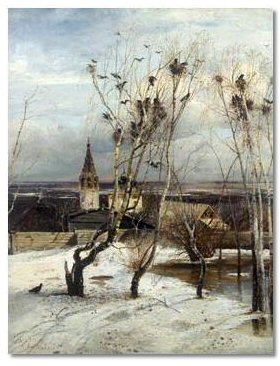A
Gestalt Therapy Session
A
couple of words about ideas in art
__________________________________________________________________
Dear
readers! I do not want to launch yet another philisophical discussion
about ideas in art. Instead, I suggest that you develop your own
approach.
This small gestalt session is aimed at helping you to reach this
goal. Let's
get started, if you do not mind.
* * *
 |
|
Please
look at the painting by A.K. Savrasov "Rooks Are Back
Again" (1871). (In Russia, it is a well-known
picture, every schoolboy and schoolgirl are familiar with.
The painting is displayed at the Moscow Tretyakov Gallery.)
Do not hurry. Wait until some feelings or thoughts come
to you.
Now
try to reflect upon the picture. Why did the painter decide
to show a bell-tower in his painting? Can hovels without
windows tell you about something? What are your feelings?
What is the general idea of the rooks' return? Can you
make any sense of the pictuire at all?
To
those of you who are practicing photographers :-),
I would like to add a couple of additional questions.
Is it good
to have the skyline in the center? What about the branch
in the left part of the picture? Does it attract too much
attention?
|
Have
you answered all the questions? Have you developed your own opinion?
Good. Now lay aside the article. Walk about your room for a while.
Then get
back to reading.
S.
M. Sandomirsky wrote: "The
meaning of the picture is simple. People, who
live in low houses behind high fences, are far from any spiritual
demands.
Ministers of religion are somewhat above everyday minor activities
(above
the horizon), while the bell-tower, similar to religious aspirations,
rises
even higher: it is shown as a high distinct object. Still the tower
fails to
reach bright clouds and clear sky. Only birds not only fly in the
blue sky
of spirit, but also live there — that is their permanent residence".
Now
it is time for another short break. Limber up a little. Pat your
dog or
cat, if you have any. Scratching your head is also a good option.
After that we can continue with our session.
Now,
with your permission, I shall give you my version. The meaning
of the
picture is simple. The constant flow of life is starting its
new cycle. The
rooks are back. The snow has not melted away yet, and the sky is
full of
plumbeous grey tints. Nevertheless, rooks are busy building their
nests. We
are standing on a hill and looking into the distance. Something
exciting and
penetrating is felt in the air of an early spring. Against the
background of
this feeling, we realize our loneliness. And hope. It is felt through
the
return of the birds. Aren't we similar to them? Is our life also
a vain
continuous round of events, which repeats itself while being slightly
different each time?
Compare
your feelings and thoughts with those of Sandomirsky and me.
Stand
up and come up to the window, please. Look into the distance. If
you are not
in the mood to continue reading, give it up. Why forcing yourself?
It is
just an idle matter, you know.
Well, if your decision was to continue, welcome back.
Fritz
Perls, one of the founders of gestalt therapy, once said: " … we
are not
analyzing. We are just integrating." Consider all three interpretations
(including yours) from this point of view. What dominates in them?
Analysis
or integral perception? Or maybe all of them contain something
else which is
very important. Or maybe something important is missing in all
of them?
Look
again at the picture. Can all those words (including yours) substitute
the vivid perception of a piece of art? If the idea does exist,
can we
verbalize it? What do we need words for? Why is the idea important
to us? Do
we need the idea at all? Answer all those questions.
Now
take a deep breath. Relax. Smile. The session is over. Thank
you.
*
* *
A
couple of unnecessary but interesting remarks
1. I
have got a question for you now. Did you manage to catch the meaning
of my text? If yes, what is all about? Frankly speaking, I just
wanted to stimulate your individual process of perception and
thinking. That is all. If you found any other ideas in this text,
those are your ideas, not mine. This result is quite normal.
It is a natural sequence of a successful gestalt therapy. :-)
2. Ideas
in art can be treated in a different way. In physics, there is such
a thing like Bohr's Principle of
Complementarity. In my opinion, this principle can be extended
and applied to arts (I may be not the first guy, who developed
such an approach). As far as art is concerned, this principle
can be formulated in the following way. All possible interpretations
of a piece of art do not contradict each other. They are rather
mutually complementary. Such an idea may restore your peace of
mind, if you are unhappy with the main part of the article.
November
17, 2004
*
* *
Links
1.
Igor Yefremov. Creating and Understanding Art. Philosophical
micro-essay
2.
Igor
Yefremov. Tao Te Ching And Photography. The Heavenly Way to Perfection
for Photographers. Yet another attempt to stimulate your
understanding of art.
